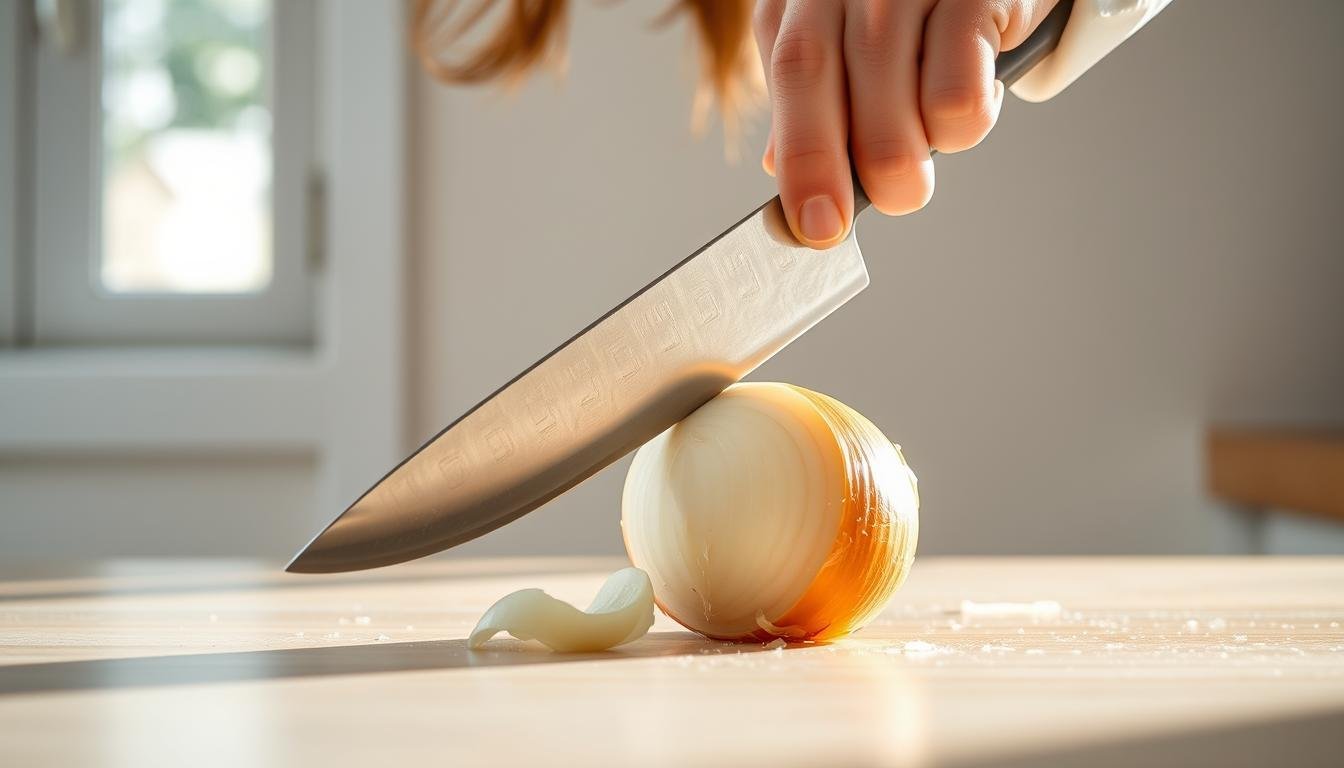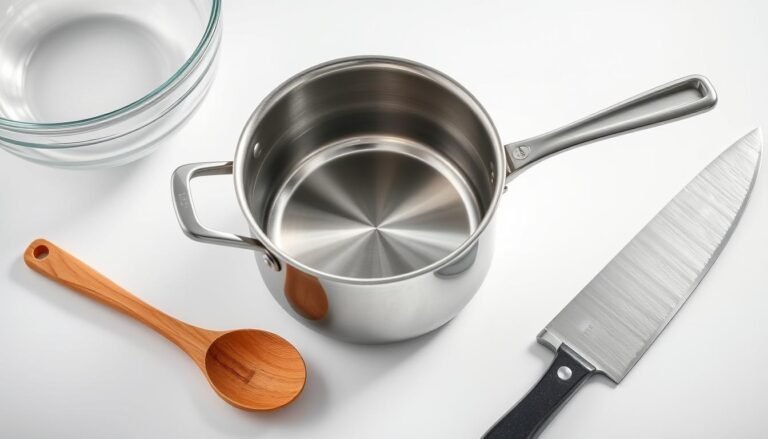Disclosure: This Post Contains Affiliate Links; We earn a commission on purchases.
Chopping onions is a basic task in many kitchens. But, it often makes us cry and feel uncomfortable. The release of irritant enzymes when an onion is cut is the main reason for this.
Knowing why and how to chop onions without crying can change your cooking. This article will show you different ways to tear-free onion cutting. You’ll learn how to cook without the trouble.
Key Takeaways
- Effective methods for chopping onions without crying
- Understanding the science behind onion-induced tears
- Practical tips for tear-free onion cutting
- Exploring various onion chopping techniques
- Improving your cooking experience with simple hacks
Why Do Onions Make Us Cry?
Onions make us cry when cut because they release a compound. This compound reacts with our eye water, causing irritation and tears. It’s a complex mix of chemistry and biology.
The Science Behind Onion Tears
The gas from the onion causes the tears. Dr. Stuart Farrimond says onions release syn-Propanethial S-oxide when cut. This gas mixes with eye water to make sulphuric acid, leading to irritation and tears.
Syn-Propanethial-S-oxide: The Tear-Inducing Compound
Syn-Propanethial-S-oxide is the main culprit. When onions are chopped, this gas is released. It mixes with eye water to form sulphuric acid, irritating the eyes and making us cry.
Different Onion Varieties and Their Tear Factor
Not all onions make us cry the same. Some onions cause more tears than others. This is because of their sulfur content and the enzymes they have.
Choosing the right onion can help. Some onions, like sweet onions, have less sulfur. This makes them less likely to cause tears.
- Onion variety affects tear production
- Sulfur content is a key factor
- Some onions are bred to be less irritating
What is the Best Way to Chop Onions Without Crying?
Chopping onions without tears is a big challenge for many. It’s a key skill in cooking, but the gas from onions can make your eyes water. Luckily, there are ways to lessen this problem.
Scientifically Proven Methods
Using a sharp knife and making slow cuts helps a lot. A sharp knife hurts the onion less, so less gas is released. Also, cutting on a stable cutting board and keeping the onion steady helps even more.
Popular Folk Remedies: Do They Work?
Many people try to avoid crying by chilling onions or cutting under cold water. Some even use a fan to blow gas away. These methods can help a bit, but they don’t work for everyone.
Comparing Effectiveness of Different Techniques
Combining different methods can be the best approach. Using a sharp knife, chilling the onion, and cutting slowly can really help. A study showed that this mix is the most effective way to chop onions without crying.
In short, there’s no single perfect way to chop onions without crying. But mixing scientific methods with some folk remedies can make it much easier.
Temperature-Based Methods
Changing the temperature when chopping onions can help avoid tears. These methods reduce the irritating compounds that cause eye irritation.
Chilling Onions Before Cutting
Chill onions in the fridge for 30 minutes before chopping. This slows down the chemical reaction that makes you tear up. It reduces the release of syn-propanethial-S-oxide, the eye-irritating compound.
Freezing for 10-15 Minutes
Freezing onions for 10-15 minutes also works. It slows down the enzymes that make you tear up. This is great for pungent onions.
Using Cold Water While Cutting
Chopping onions in cold water is helpful too. There are two main ways to do this:
Running Water Technique
Chop onions under cold running water. This washes away the irritant as it’s released. It’s effective but needs careful handling.
Ice Bath Method
Or, put the onion in an ice bath while chopping. The cold water captures the irritants, reducing their release. This method is good for those who like a controlled space.
Using these temperature methods can greatly reduce onion chopping discomfort. Whether you chill, freeze, or use cold water, these hacks help avoid onion tears.
Proper Cutting Techniques and Tools
To chop onions without crying, you need to know the right techniques and tools. The right way can make you less likely to tear up.
Sharp Knife Techniques to Minimize Damage
A sharp knife is key when chopping onions. A sharp blade hurts the onion less, so it releases fewer irritants. This simple trick can help you avoid tears.
Correct Cutting Board Position
The cutting board’s position matters too. Make sure it’s stable and secure. This helps you cut better and bruise the onion less, which means less gas is released.
Specialized Onion Cutting Tools
There are specialized tools for safer, easier onion chopping. These include:
Onion Choppers and Dicers
Onion choppers and dicers help minimize manual chopping. They keep the onion and its irritants in. They’re a fast, easy way to chop onions without tears.
Food Processors and Blenders
For big batches or complex recipes, use a food processor or blender. They chop onions fast, keeping you away from the irritating gases. This makes chopping onions less tear-inducing.
Using sharp knives, the right cutting board, and special tools can lessen onion chopping discomfort. Try these methods to find what works best for you.
Physical Barriers and Protection Methods
To avoid onion fumes, using physical barriers is a good idea. This method stops onion vapors from getting to your eyes.
Protective Eyewear Options
Wearing protective eyewear is a smart choice. Onion goggles are made just for this. They keep your eyes safe from onion vapors.
Creating Proper Ventilation
Good kitchen ventilation is also key. A strong fan or your kitchen exhaust fan can blow vapors away. This helps keep your face clear.
Face Shields and Masks
Face shields or masks can also help. They’re usually for splatter, but they work against onion fumes too.
Distance Cutting Techniques
Cutting onions far from your face is another good trick. This way, vapors are less likely to hit your eyes.
Some top ways to prevent crying while chopping onions are:
- Using protective eyewear like goggles
- Ensuring proper ventilation with fans or exhaust systems
- Wearing face shields or masks
- Employing distance cutting techniques
Adding these physical barriers to your onion chopping can really help. You’ll tear up less often.
Quick Kitchen Hacks for Tear-Free Chopping
Chopping onions doesn’t have to make you cry. Quick kitchen hacks can help you chop onions without tears. These simple tricks make cooking more fun.
Breathing Techniques and Mouth Tricks
One easy way to cut down on onion tears is to breathe right. Exhale while chopping to keep syn-propanethial-S-oxide away from your eyes. Some folks use a match or candle near the onions, but its success is up for debate.
Strategic Positioning in Your Kitchen
Where you stand in the kitchen matters too. Stand back from the board or use a fan to blow gas away. A study shows this can really help.
Lighting a Candle Near Your Cutting Board
Lighting a candle near your board is another trick. The flame might neutralize the gas that makes you cry. Many cooks find it helpful, even if it’s not proven.
Using Lemon or Vinegar Solutions
Try using lemon or vinegar while chopping onions. The acid can break down the gas that irritates your eyes. Try different methods to find what works best for you. Say goodbye to onion tears for good.
Conclusion
Chopping onions without crying is a skill you can learn. It’s all about the right techniques and tools. Home cooks can chop onions without tears by understanding why onions make us cry.
Using sharp knives and proper cutting techniques helps a lot. Wearing protective eyewear and creating good air flow also helps. Special tools for cutting onions can reduce irritation too.
To chop onions without tears, mix these methods together. Try different ways to find what works best for you. Whether you’re a pro chef or just starting, these tips will make cooking with onions easier.
By using these simple methods, you’ll soon know how to chop onions without crying. You’ll be confident in your cooking skills.
FAQ
What causes onions to make people cry?
Onions release a gas called syn-Propanethial-S-oxide. This gas reacts with your eye’s water to form sulfuric acid. This acid irritates your eyes, making you tear up.
Does the type of onion affect tear production?
Yes, different onions have different levels of syn-Propanethial-S-oxide. Sweeter onions are usually less irritating.
How can I chop onions without crying?
You can chill or freeze onions before cutting. Use a very sharp knife or cut under cold running water. Wearing protective eyewear also helps.
Is it effective to chill or freeze onions before chopping?
Yes, chilling or freezing onions slows down the release of syn-Propanethial-S-oxide. This reduces tear production.
Can using a sharp knife really make a difference?
Yes, a sharp knife causes less damage to the onion. This means fewer irritating compounds are released into the air.
Are there any specific tools that can help with tear-free onion chopping?
Yes, onion goggles, face shields, and sharp knives or tools can help. They reduce exposure to the irritating gas.
Does cutting onions under cold water help?
Yes, cutting onions under cold water dilutes and washes away the gas. This reduces eye irritation.
Can lighting a candle near the cutting area help?
Some people think lighting a candle near the cutting area helps. It’s said to neutralize the gas. But, this method is mostly based on personal experience.
Are there any breathing techniques or other hacks that can help?
Yes, breathing through your mouth or holding your breath while cutting can help. Also, position yourself to avoid gas reaching your eyes.

With over a decade of experience turning everyday ingredients into reliable, crowd-pleasing meals, Ryan knows firsthand the frustration of wasting time and effort in the kitchen. He specializes in clear, no-fuss guidance—breaking down techniques, time-saving tips, and smart shortcuts so that even complete beginners feel empowered and confident.
Subscribe to Our Newsletter













